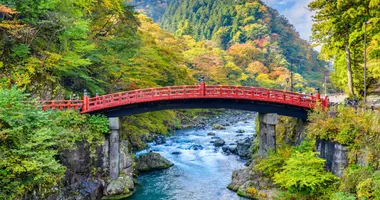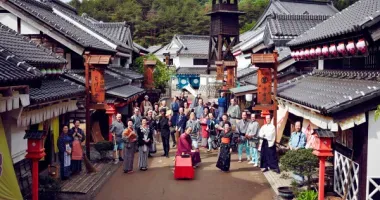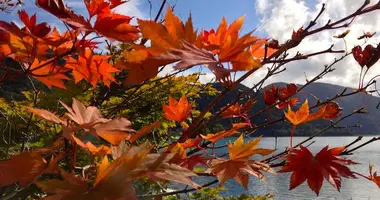Lake Chuzenji & Kegon Falls Guide
- Published on : 13/05/2014
- by : Japan Experience
- Youtube
Lake Chuzenji, Nikko, Tochigi Prefecture 中禅寺湖 華厳滝 日光 栃木県
Johannes Schonherr
Famed as an escape from the heat and humidity of the Tokyo summers, Lake Chuzenji (Chuzenji-ko in Japanese) is located high up in the mountains above Nikko in Tochigi Prefecture. At an altitude of 1269m, the lake provides a fresh breeze even on the hottest August days.
Though its climate is certainly not the only reason making it worth a visit: the scenery is always breathtaking. Be there cherry blossoms or autumn leaves in the foreground, the dominating Mount Nantai (2486m) and its companions are always in the background behind the lake.

Chuzenjiko, Nikko, Tochigi.
Irohazaka
But first you have to get there. Shortly behind Nikko city, the Irohazaka starts. That's the hairpin curving, serpentine road that leads up to the lake. It covers a height difference of about 400m in the span of just a few kilometers.
Today, the up and the down parts of the Irohazaka are separate, providing for one-way roads each way. The upward road is wider and quite easy to drive, the downward part demands a serious foot on the brake and quite some caution.
Though the main traffic consists of cars, motorbikes and buses, quite a few bicycle riders can also be seen fighting hard on their way up. All decked out in serious bike gear and no doubt, their bikes are not of the variety you usually see parked at the train station.
Each curve is marked by a number (20 on the ascent, 28 on the descent) and a Japanese hiragana letter. The number of the curves comes to 48 - the same as the number of hiragana letters. Thus the whole alphabet is covered.
The order of the letters is not today's standard school A-I-U-E-O though but I-Ro-Ha. The letters are ordered in the way of the ancient Iroha poem which uses all hiragana letters exactly once. A common ordering practice actually before the current hiragana alphabet was popularized during the Meiji Period. Thus, the road is named Irohazaka (Iroha Slope).

Akechidaira view to Lake Chuzenji & Kegon Falls, Nikko, Tochigi.

Mount Nantai and Lake Chuzenji, Nikko, Tochigi.
Akechidaira Cable Car
At the upper end of the Irohazaka but still in quite a distance from Lake Chuzenji, you will arrive at a rest house / cable car station. The cable car will take you up to the Akechidaira Peak and the one-way trip takes only two minutes. For such a short ride, 700 yen seem to be outrageously expensive (though that price covers the return trip). But once you are up on the peak, you will know that the money was very well spent - provided the weather is on your side.
From up there, you get not only a gorgeous view over the whole of Lake Chuzenji but also onto the Kegon Falls right below.
The Kegon Falls, often described as Japan's number one waterfall, takes the overflow water out of Chuzenji-ko. It's a site absolutely worth visiting all by itself. More on the falls further below.
Finally, you enter Chuzenji Onsen, the main town at the lake. Shortly before you reach the lake, you pass a giant Shinto Shrine Gate. The lake and Mount Nantai are still considered sacred.
According to some sources, Mount Nantai and parts of the lake were considered such highly regarded sacred grounds that up until 1872 women, horses and cows were prohibited to enter.
Right before the lake shore, turn to the left. The road will lead out of Chuzenji Onsen and eventually onto an observation point up on a peak. From there, you get the perfect view over Lake Chuzenji with Mount Nantai right behind it. That road will be closed from 5 pm on, though. A serious gate is in place.

Lake Chuzenji (Chuzenjiko), Nikko, Tochigi.
Trout
Driving back into Chuzenji Onsen it might finally be time to think about what the local food might be.
Driving along the lake, you see a lot of anglers trying to catch some fish from the lake. Local fish, trout in particular is the specialty here. Plenty of restaurants along the lake shore serve it.
The restaurant I entered was called Maple and it had a Canada-inspired sign outside complete with the red maple leaf. Inside, it was certainly western style but there wasn't any particularly Canadian about it. It displayed a stuffed black bear sitting on a bar stool and various other hunting trophies but they were all local. Bears are no rarity further up the mountains here.
Fresh fried trout was on the top of the menu.
Got to say, the trout was excellent. On the way out, I also bought a smoked trout to take home.

Fried trout at a restaurant on the shores of Lake Chuzenji, Nikko, Tochigi.
Kegon Falls
Pretty much in the center of Chuzenji Onsen are the Kegon Falls. With a height of 97m they are about the highest major waterfall in Japan. As you would expect from such a tourist attraction, there is plenty of (paid) parking and a small village of tourist shops has been built opposite the upper reaches of the falls.
You can take an elevator down to see the falls from below. Kegon surely is a beautiful waterfall.
Conspicuously absent from all the display boards detailing geological information of the falls and its creation by an eruption of the Nantai volcano 20.000 years ago is its more recent tragic history.

Kegon Falls, Nikko, Tochigi.
Kegon Falls Suicides
In 1903, a 16-year-old Tokyo high school student named Misao Fujimura committed suicide by jumping down the fall. Before he jumped, though, he carved a well-thought out romantic poem into a tree trunk right above the fall. It starts out with the lines:
"How immense the universe is!
How eternal history is!
I wanted to measure the immensity with this puny five-foot body."
Fujimura having been the son of a high-ranking family and a student at the prestigious Tokyo Imperial University (now Tokyo University) with famous writer Natsume Soseki being his English teacher, the press covered the incident in detail, reprinting his poem over and over again.
The result? A Werther Effect among alienated young Japanese. Affected by Fujimura’s mysterious death poem, close to 200 young folks tried to follow his mortal path down the Kegon Falls within the next 10 years. The authorities are still concerned today.
Monkeys
The same concerned authorities put up plenty of signs around the Kegon warning of wild monkeys.
After walking around for while at the Kegon grounds you will most likely encounter a family or two of them. They are used to humans and not shy at all - but they can be aggressive. Make sure to keep a distance.
Driving along the other side of the lake, at the foot of Mount Nantai, provides plenty more sights. One of the most visited is the Ryuzu Falls. Here, the Yugawa River wildly cascades down the lava bed of Mount Nantai towards Chuzenji Lake.
Did I already mention that Chuzenji Onsen translates as Chuzenji Spa? That's right. The Chuzenji area has plenty of hot springs - and if you pick your hotel / ryokan to stay accordingly, you can finish the day with a great hot bath in an outdoor pool heated up by the volcanic powers of Mount Nantai.

Ryuzu Falls, Nikko, Tochigi.

Autumn colors at Kegon Falls, Lake Chuzenji, Tochigi, Japan
Hotel Accommodation in Nikko
Nikko has hotel accommodation to suit all budgets. Some recommended places to stay in Nikko include the Nikko Station Hotel Classic right at Nikko Station with an indoor hot spring bath and terrace, the Japanese-style Nikko Tokanso with tatami rooms and for budget travelers the Nikkorisou Backpackers.
At Lake Chuzenji and Kegon Falls choose from the Hotel Kohantei, the Yama-no-Yado Sugimoto-kan, the Hotel Shikisai and the Nikko Lakeside Hotel.
Nikko Access
Train
From Tokyo, Nikko is accessible via the Tobu-Nikko Line (aka Tobu Skytree Line) from Asakusa station. The tokkyu (Limited Express train) takes 1 hour 50 mins, and the kaisoku (Rapid) takes 2 hours.
IMPORTANT: Check beforehand with the station staff whether or not you need to change trains at Imaichi. Asking this question could save you hours.
To ask in Japanese: Imaichi (EE-MY-CHEE) de norikae no hitsuyo ga arimaska? or, better still, go here to print the question out in Japanese (as an image file, so doesn't require Japanese font capability) and simply show the printed question to the station staff.
For JR Rail Pass holders, an alternative route is by shinkansen (bullet train) to Utsunomiya (50 mins) and then a local JR train to Nikko (45 mins).
Nikko-Kinugawa Pass
Available from Tokyo Asakasa station - this 2-day pass includes train travel (though not the Express surcharge) to Nikko, bus travel between Nikko, Chuzenji Lake, Kinugawa onsen and Yumoto onsen, as well as boats and cable cars in these areas.
Access to Nikko from Nikko Station
From the Tobu line Nikko station to the Nikko temple and shrines (known as the "Nikko San'nai" area), it is a 5-minute bus or taxi ride, or a 20-minute walk. The bus station is right in front of the train station, and the road up to Nikko San'nai is the road visible beyond the bus station.

Lake Chuzenji, Nikko, Tochigi.
Related Links
Kirifuri Highland & Kawaji Onsen
Books on Tokyo Japan
Lake Chuzenji & Kegon Falls guide: read a travel guide to the spectacular Lake Chuzenji (Chuzenji-ko) and the Kegon Falls near Nikko in Tochigi Prefecture.















